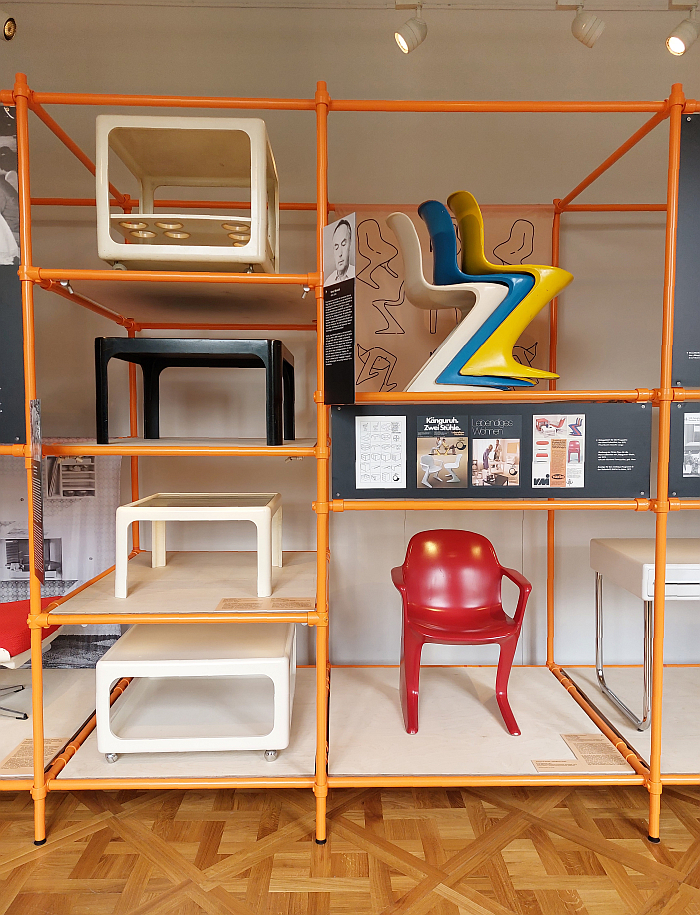PURe Visions. Plastic Furniture Between East and West at the Kunstgewerbemuseum, Dresden
For all that steel tubing is the popular personification of the rise of the novel in furniture and interior design in context of the developing industrialisation of the first third of the 20th century, that primary representative of the rise of the machine and its victory over craft, in many regards the real symbol of the progress of the period was the novel synthetic plastics being developed, Bakelite being inarguably the best known and most widely employed.
Yet while in the 1920s and 30s the likes of a Christian Dell developed interesting, instructive, objects from novel plastics, ably demonstrated the possibilities of the novel materials contemporary chemistry was bringing forth, their use in objects of daily use remained limited, not least on account of problems of structural stability and durability; limited, save, arguably, and unfortunately, Bakelite’s use in the construction of Walter Maria Kersting’s Volksempfänger radio, that piece of contemporary design the NSDAP used so efficiently and so knowledgeably to transport their nefarious agenda and toxic propaganda into every home. Yes, there is a lesson to be learned there.
The 1930s however also saw the first patents for a novel synthetic plastic that would not only demonstrate the possibilities of the novel materials, but which had the characteristics to enable it to make those possibilities realities: polyurethane
A material that, it’s fair to say, on its commercial introduction in the 1960s, revolutionised not only furniture design but furniture production as fundamentally as a Michael Thonet once had with his adaptation of the dark art of woodbending. While the colour polyurethane enabled brought a vitality and freshness and exuberance that, it’s equally fair to say, revolutionised interiors. Allowed 1960s and 70s interiors to Pop.
And while today polyurethanes are more critically analysed than they once were, their use is rightly questioned today, as is the proposition of alternatives actively considered, the developments of the 1960s and 70s, the positions that were advanced in that period and the understandings of furniture that arose in that period remain.
If often popularly only very poorly, superficially, understood.
As is the (hi)story of furniture and interior design in the two Germanys of the 1960s and 70s.
As are the intersections of the political, economic, social (hi)stories of the two Germanys of the 1960s and 70s.
With PURe Visions. Plastic Furniture Between East and West the Kunstgewerbemuseum Dresden go deep into the (hi)story of polyurethane furniture in the two Germanys of the 1960s and 70s and thereby also allow one to approach better appreciations of the (hi)story of furniture and interior design in the two Germanys, and of the wider (hi)story of the two Germanys……
As an exhibition PURe Visions. Plastic Furniture Between East and West has its origins in, can very much be considered an off-shoot from, the exhibition German Design 1949–1989. Two Countries, One History, a co-production between the Kunstgewerbemuseum Dresden and the Vitra Design Museum, a project that, as can be gauged in our interview with co-curator Klára Němečková, not only produced a great many questions that had only rarely, if ever, been publicly posed before, but also helped expose the urgent need to develop a more probable, more durable, narrative of design in the lands of the current Germany between 1945 and 1990. A narrative free of much of the jaundice and stereotype and easy cliche that so popularly defines the current popular narrative. And also to ensure that that narrative is a little more centred, doesn’t lean so much to the west as it currently tends to.
And also has, in many regards, its origins in the so-called Känguru Stuhl, Kangaroo Chair a.k.a. Z Chair by Ernst Möckl, a work designed in West Germany, produced and sold in East Germany and West Germany, if arguably more successfully in the East, and which today exists, for all online, with all manner of wild, fantastical, impossible, biographies. And a Känguru Stuhl that also neatly summarises the problems of the exercise the Kunstgewerbemuseum initiated: not only are the (hi)stories the Kunstgewerbemuseum sought to explore insufficiently popularly recorded, nor only is and was reliable information rare, but locating the sources of that reliable information comes with its own not insignificant problems, and that largely on account of the context within which the (hi)story was written, the background against which polyurethane furniture was developed, produced and sold in the two Germanys of the 1960s and 70s.
Then the path of the Kunstgewerbemuseum, Dresden, crossed that of Leipzig based author Sascha Lange who was in the process of researching that very (hi)story of the polyurethane furniture of the two Germanys, research that was recently published as Möbel aus der Zukunft. Eine deutsch-deutsche Geschichte.
And with that crossing of paths, and Sascha’s input and consultancy, the way to PURe Visions was laid.
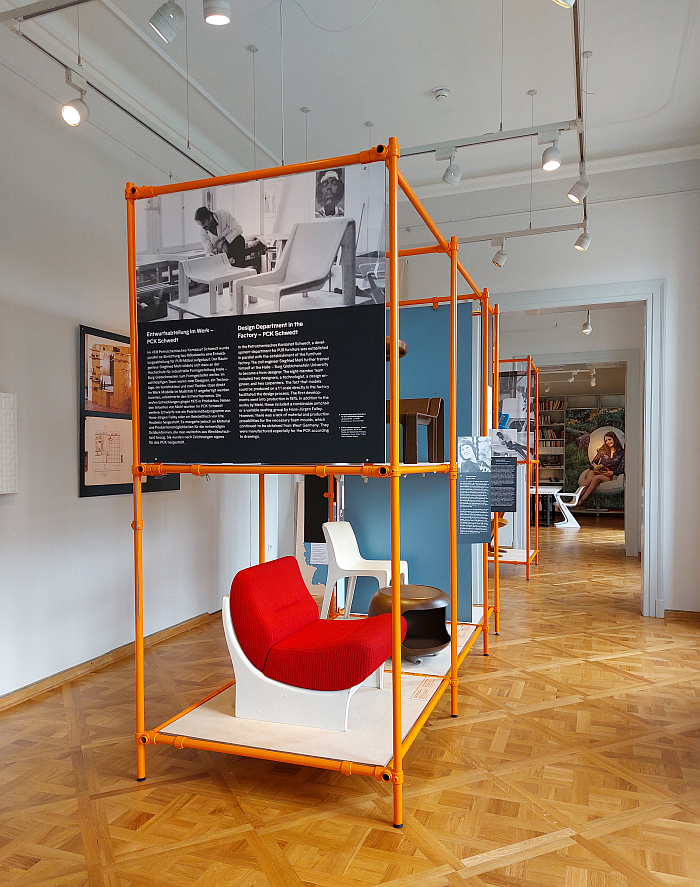
Carat 8 lounge chair Hans-Jürgen Falley, as seen at PURe Visions. Plastic Furniture Between East and West, Kunstgewerbemuseum Dresden
As an exhibition PURe Visions opens with the eponymous 1968 Panton Chair by Verner Panton for Vitra, the first chair formed in a single mould from polyurethane, that first tangible, inarguable, demonstration that polyurethane was a suitable and appropriate material for furniture; a suitability and appropriateness elegantly underscored by the fact the Panton Chair is a cantilever. And thus not only a structurally and statically very complex work, but a work that re-imagined the steel tubing of the 1920s and 30s in the polyurethane of the late 1960s, united the revolution and hopes of the 1920 and 30s with the revolution and hopes of the late 1960s, and in doing so tends to confirm that synthetic plastics were the genuine symbol of the revolution and hopes of the 1920s and 30s. If we would, must, point out, that the Panton Chair on show in PURe Visions is white, Panton’s least favourite colour, Panton’s most despised colour, Panton’s PURe Horror; lest we forget Verner Panton once called for a special tax on white paint.
If a white that one meets more often in the course of PURe Visions than one might expect, certainly more often than a Verner Panton would approve of; yes the bright oranges, yellows, reds et al are all there, are all present and correct, and are all loud, but are far from being defining.
Nor is Möckl’s Känguru Stuhl, or indeed Peter Ghyczy’s Garten Ei, Garden Egg, that other so instantly recognisable work of the period, both in East Germany and West Germany, the defining exhibit. Or at least not defining as physical objects.
However, the biographies of the Känguru Stuhl and the Garten Ei largely define the narrative of PURe Visions, a narrative that, as with biographies of the Känguru Stuhl and the Garten Ei, effortlessly elucidates the regular exchange between East and West in context of the development of polyurethane furniture; exposes the close commercial arrangements of the 1960s and 70s that saw money and goods flow in both directions across that, apparently, closed border; or embodies the similarity, the identicalness, of the polyurethane furniture on the western market and the eastern market in the 1960s and 70s. The fact that works such as the Känguru Stuhl, the Garten Ei and a great many others existed on the East Germany market and West German market. And the reasons why that identicalness in two, apparently, diametrically juxtaposed Germanys.
A narrative that begins in 1960s West Germany with Bayer’s development of novel types of polyurethane on the basis of the company’s 1930s patents, including that polyurethane employed for the Panton Chair, and from there moves on explore the attempts in 1960s and 70s East Germany and West Germany to both develop polyurethane industries and also polyurethane furniture markets; a narrative framed between the optimism, the unshakeable belief, in polyurethane of the early 1960s and the wake-up calls of the oil crises of the early 1970s; a narrative which takes you to locations as varied as Leverkusen, Rudersberg or Lemförde in the former West and to Schwedt, Bernsdorf or Schwarzheide in the former East, the latter two forming a neat Sachsen-Brandenburg triangle with Spremberg, home of Römmler AG for whom Christian Dell once produced plastic objects, where in the 1920s and 30s Christian Dell developed the novel trade of the Plasticsmith, and thus a (further) reminder that before the 1939-1945 War the most avant-garde and progressive corner of the, then, Germany was to be found in the east. Which is always worth reflecting on.

A selection of objects including, bottom left in white, the hexagonal table/stool/shelving by Manfred Rathgeber, as seen at PURe Visions. Plastic Furniture Between East and West, Kunstgewerbemuseum Dresden
And a narrative that particularly pleasingly takes lot of time to introduce a great many of the varied and various designers of the period, the greater many of whom, we are fairly certain, only very few of you will be familiar with, but whose works and biographies are every bit components of the (hi)story of design and the (hi)story of furniture as the works and biographies of those designers of whom you have heard.
Designers including, for example, and amongst many others, Ute Heublein, a graduate of Burg Giebichenstein, Halle, whose 1973 Diploma project concerned itself with polyurethane, and who in the course of her career served a tenure as a project manager responsible for the development of new polyurethane furniture objects for PCK Schwedt; the French designer Gilles Thevenot who, one learns, and not uninterestingly so, studied in La Chaux-de-Fonds, Switzerland, the home town of Le Corbusier and where the earliest Le Corbusier works were realised, and a Gilles Thevenot who designed many important, pioneering, works for Rudersberg, near Stuttgart, based manufacturer Horn. Or Axel Bruchhäuser, an engineer who, and as one can read in much more detail in Sascha Lange’s Möbel aus der Zukunft, was, through his family’s furniture business, Paul Bruchhäuser & Sohn in Gustrow, Mecklenburg-Vorpommern, a key protagonist in the development and establishment of polyurethane furniture in the DDR, and a key mediator between East and West, before in 1972, following the forced nationalisation, socialisation, of the family business he and his father skipped West where they purchased an established, and one can argue leading, West German polyurethane furniture producer: TECTA. A company they however repositioned as a manufacturer focussing on works by Functionalist Modernists architects and designers and by a younger generation of designers and architects critically questioning Functionalist Modernist positions. A switch of focus by the Bruchhäusers that, one supposes, was a response to the wake-up call of the oil crises and the appreciation that polyurethane’s glory days, glorious as they had been, were almost over. Imagine if they hadn’t!
And not only are the featured designers largely unknown but the objects featured are predominately works rarely seen; works which in their variety underscore not only the variety of possibilities polyurethane promised, but also underscore the tangible desire for the novel at that period, an urgent desire to experiment, innovate, to develop novel solutions for questions old and new, to challenge the boundaries of polyurethane, on the path to the brave new future that was rapidly, inexorably, approaching.
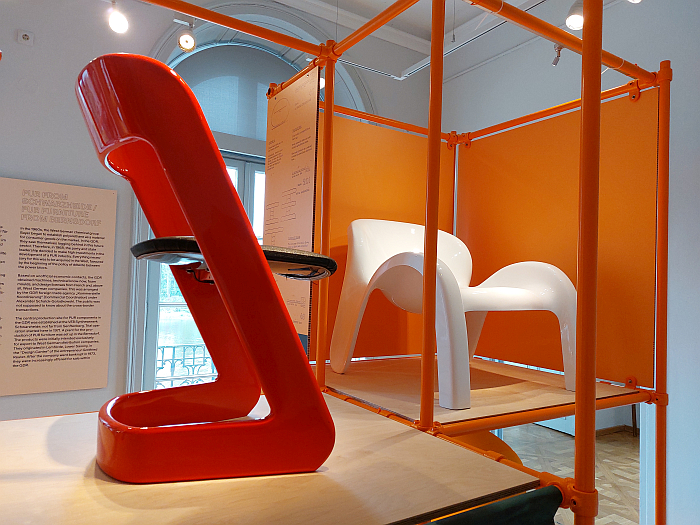
The Lucy folding chair and GN2 lounge chair, both by Peter Ghyczy, as seen at PURe Visions. Plastic Furniture Between East and West, Kunstgewerbemuseum Dresden
For our part we spent a great deal of time, so much time in fact that we got locked in the exhibition… no honest, and not even on purpose, we were just so lost in our thoughts, the stories, the (hi)stories, the objects, wandering off down previously unseen paths, that we ended up locked in, which, yes, we admittedly quite enjoyed, but that’s another story…. we spent a great deal of time with, and amongst many others, the 1972 Carat 8 lounge chair by Hans-Jürgen Falley through PCK Schwedt, essentially a crescent moon in which you can relax and unwind; with the Lucy folding chair by Peter Ghyczy through VEB Synthesewerk Schwarzheide an object which, as with several others on show, combines metal with polyurethane, and is also a very nice, very elegant, example of the storable, temporary, space-saving, furniture that the new apartments of the era demanded; with an early 1980s occasional table by Siegfried Mehl and W. Jedrych that was part of the so-called Schwedt 82 collection through PCK Schwedt, an occasional table which not only helps elucidate the formal possibilities polyurethane enabled, and thus why it was so keenly used, but which contains a couple of very nice functional features including, unless we’re mistaken, which we often are, the possibility of using the raised ledge as a place to lay an open book, that table-as-page-marker trick which always delights. For all when it is as formally satisfyingly, and naturally, executed as in Mehl and Jedrych’s table.
Or with the 1970 table/stool/storage module Hexagon by Manfred Rathgeber realised in context of the West German Elastogran Design Centre, produced in East Germany by VEB Synthesewerk Schwarzheide, and sold in the West as part of the Form + Life Collection through, laterally, Minden based manufacturer Drabert, and which can be used individually, or used collectively as either a horizontal landscape or as a stacked vertical landscape. And which as a work not only represents that search for multi-functionality and flexibility in furniture design that, as with the development of the storable, temporary, space-saving, furniture, was, arguably, every bit as defining an aspect of the 1960s and 70s as the novel colours, forms and materials, which remains one of the abiding legacies of the 1960s and 70s, albeit an aspect which often gets lost in the focus on colours, forms and materials, but also is a work whose biography stands as much proxy for the (hi)story of polyurethane furniture design, production and retailing in East Germany and West Germany in the 1960s and 70s as those of the Känguru Stuhl and the Garten Ei. And in doing so, in being such, but being a work you’ve never seen before and which the internet has forgotten, tends to confirm and reinforce not only how much of that (hi)story of polyurethane furniture of the 1960s and 70s has become lost, and how much of the (hi)story of furniture design in the two Germanys of the 1960s and 70s has become lost, but why it’s important that those (hi)stories are rediscovered and popularly told, explored, discussed.
Why it’s important that those (hi)stories become components of contemporary discourses and debates. Of all contemporary discourses and debates, not just those concerning furniture and design.
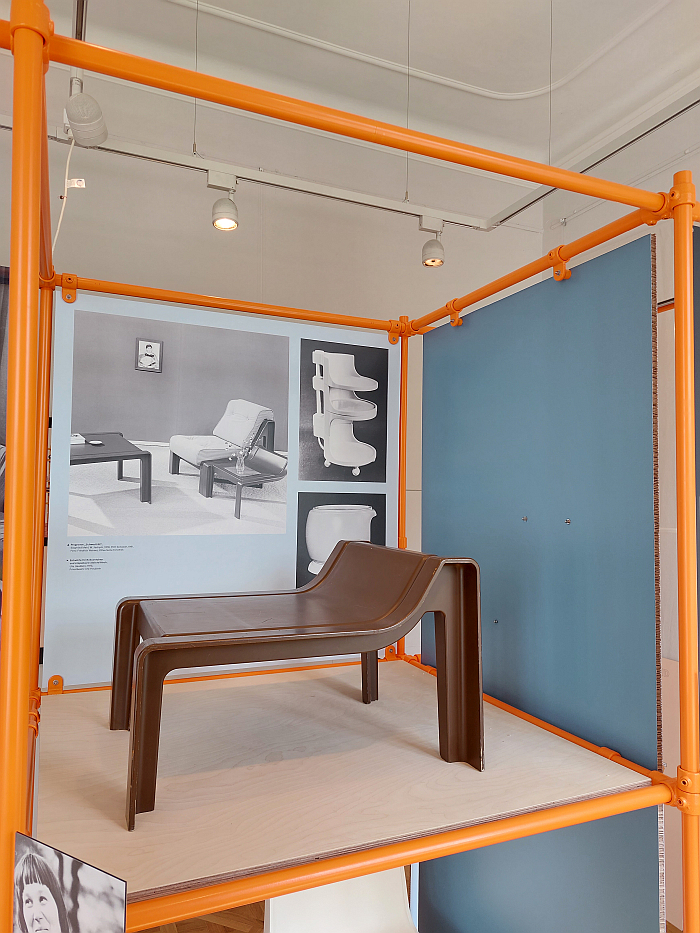
An occasional table from the Schwedt 82 collection by Siegfried Mehl and W. Jedrych, as seen at PURe Visions. Plastic Furniture Between East and West, Kunstgewerbemuseum Dresden
A co-production between the Kunstgewerbemuseum, Dresden, and the Museum Utopie und Alltag, Eisenhüttenstadt, PURe Visions is a well paced and intelligently designed showcase which through the presented objects, archive material and the succinct bilingual German/English texts, and the all important bilingual maps, allows easy access to myriad themes and discussions. A presentation which effortlessly moves beyond the objects per se to discuss, for example, the complexities of producing polyurethane and polyurethane furniture, for all in the DDR where not only financial and material resources were often a limiting factor, but human resources; or the importance of the biannual Leipzig Trade Fair as a meeting point between East and West, a location of diplomacy as much as of commerce; or to explore polyurethane furniture in actual daily use in actual homes of actual people… or rather seeks to, your photos and memories are very much requested as a way of expanding from the academic and technical narratives.
A presentation which ends with a look at contemporary relationships with, and use of, plastic in product and industrial design, it’s a museum, it’s what museums do, linking the past to the now with the inherent considerations on the similarities and differences. Whereby, if we’re being honest, which we always try to be, when we were there, locked in, enjoying being locked in, the final chapter was still in the process of being assembled, thus we can’t say that much about what is presented, you’ll also notice a lack of photos, but from what we did see and thereby could imagine, it should offer a nice opportunity to reflect on the question if our contemporary plastics problem is a problem of plastics or a problem of humans. ¡¡¡SPOILER ALERT!!! it’s us and our inability to behave responsibly. As the (hi)story of 1960s and 70s polyurethane neatly elucidates.
In which context, the exhibition design is based on modules in a loud, unapologetically so, orange, exactly as polyurethane furniture is popularly understood; but modules constructed from metal… Perhaps a commentary on the changes since then?
A reminder that for all synthetic plastics were once the future it was a future human society wasn’t able to responsibly deal with, is and was (another) freedom we forgot came with responsibility. Which, again, is always worth reflecting on.
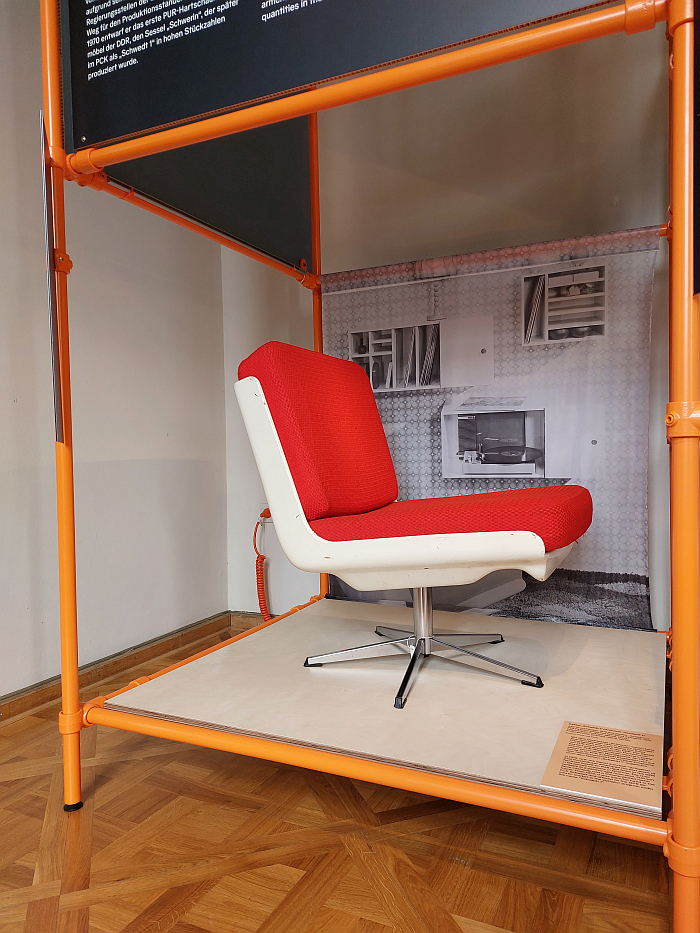
The Schwedt 1 lounge chair by Axel Bruchhäuser through PCK Schwedt, as seen at PURe Visions. Plastic Furniture Between East and West, Kunstgewerbemuseum Dresden
And a presentation which despite its scope can be but an introduction to the (hi)story of polyurethane furniture in 1960s and 70s East Germany and West Germany, is but 30 or so of the myriad polyurethane objects that were designed in those years, Sascha Lange’s Möbel aus der Zukunft ably demonstrating just how many more known objects are out there, and thereby deliciously implying how many more are still to be uncovered, relearned and appreciated. How much more work, how much more questioning, is still needed.
However, despite its relative brevity, and it is only a relative brevity, through the variety of the objects and designers, known and unknown, presented, through its detailed explanations and elucidations of the development of polyurethane furniture in East Germany and West Germany, on the many intersections of those developments, through its exposing of the daily realities of the development, production and supply of polyurethane furniture in East Germany and West Germany, PURe Visions not only provides for a very engaging and stimulating introduction to the (hi)story of polyurethane furniture in the two Germanys of the 1960s and 70s but an introduction which should help explode a lot of the objectification that surrounds objects such as the Känguru Stuhl or the Garten Ei, or the Panton Chair. Through explaining such objects in context of the wider developments of the period, through elucidating that they are but the examples you know best from a mass of other interesting and informative and very good works designed during the 1960s and 70s PURe Visions should help debunk a lot of the popular mythology surrounding such works, and thereby allow for the wider, more open, more honest, debates on the (hi)story of polyurethane furniture and on the (hi)story of furniture design globally, certainly here in Europe, that needs to be, must be, undertaken. And in doing so contribute to the formulation of the updated narrative of European furniture design (hi)story, that more probable, more durable, narrative of of European furniture design (hi)story that needs to be, must be, developed.
In addition, and equally importantly, through its narrative and the manner in which it unfolds that narrative PURe Visions allows for a pleasingly differentiated perspective on not only the furniture of 1960s and 70s East Germany and West Germany, but also on the relationships between East Germany and West Germany in the 1960s and 70s; perspectives on the, when not dependency per se, then certainly the tacit, unspoken, understanding of the ideological enemy as a natural and sensible and indispensable partner. Allows for a timeous opportunity to begin rephrasing the narrative of the (hi)story of the two Germanys of the 1960s and 70s.
A rephrasing that as so oft, furniture, as a cultural good, is an accessible, informative and highly entertaining conduit to achieving.
PURe Visions. Plastic Furniture Between East and West is scheduled to run at the Kunstgewerbemuseum Dresden, Schloss Pillnitz, August-Böckstiegel-Straße 2, 01326 Dresden until Sunday July 7th.
Full details, including information on the accompanying fringe programme, can be found at https://kunstgewerbemuseum.skd.museum
Following its run in Dresden PURe Visions will be on show at the Museum Utopie und Alltag, Erich - Weinert - Allee 3, 15890 Eisenhüttenstadt, and where the presentation alongside innumerable other examples of plastic DDR artefacts should, will, allow for a very different viewing experience than that in Schloss Pillnitz. View it twice. We will. We may even get locked in twice.
And for all keen to read deeper Sascha Lange’s book Möbel aus der Zukunft. Eine deutsch-deutsche Geschichte is available, sadly in German only, through Ch. Links Verlag, Berlin.
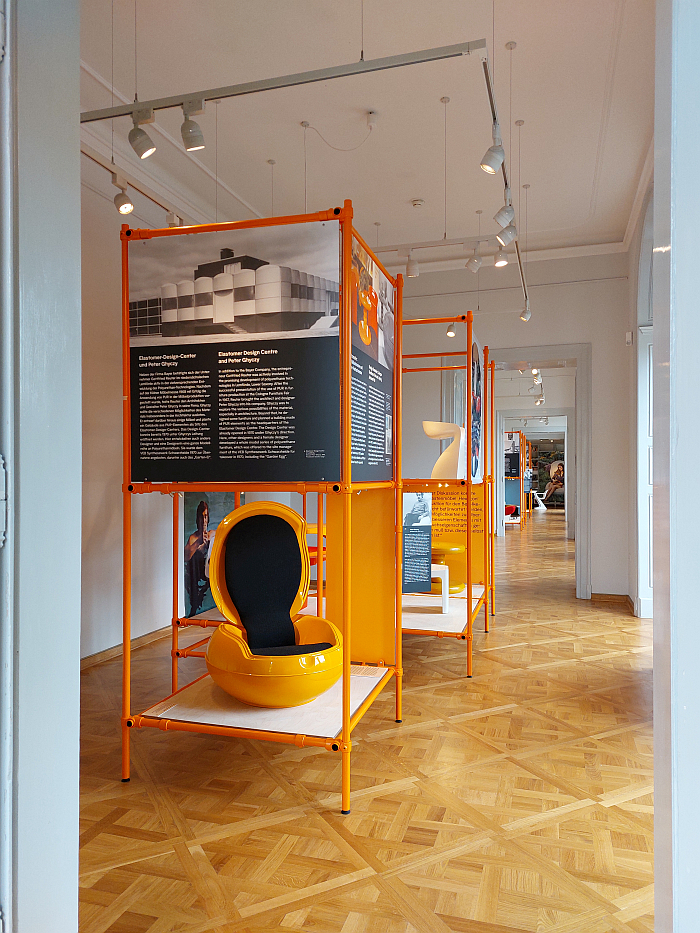
Garten Ei by Peter Ghyczy, as seen at PURe Visions. Plastic Furniture Between East and West, Kunstgewerbemuseum Dresden

A selection of objects including works by Gilles Thevenot and Rainer Moll, as seen at PURe Visions. Plastic Furniture Between East and West, Kunstgewerbemuseum Dresden

The production of polyurethane furniture as explained via the Känguru Stuhl, Kangaroo Chair a.k.a. Z Chair by Ernst Möckl, as seen at PURe Visions. Plastic Furniture Between East and West, Kunstgewerbemuseum Dresden

Componenets from Rudolf Horn’s system of modular wall elements through VEB Holz Naumburg, as seen at PURe Visions. Plastic Furniture Between East and West, Kunstgewerbemuseum Dresden

Top-Sit stool by Winfried Staeb (top) and sectional table by Manfred Rathgeber (bottom), as seen at PURe Visions. Plastic Furniture Between East and West, Kunstgewerbemuseum Dresden
Tagged with: Dresden, Kunstgewerbemuseum Dresden, Möbel aus der Zukunft, Plastic Furniture Between East and West, polyurethane, PURe Visions, Schloss Pillnitz, Seating, two germanys
